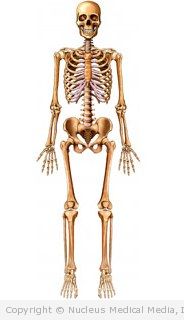Fracture – Definition
A fracture is a break in any bone in the body. Fractures are usually caused by trauma. This may be falls, twists, blows or collisions. There are different kinds of fracture:
- The bone may be fractured but stable (simple fracture).
- Bone fragments may be sticking through the skin (open).
Fractures may also be described as:
- Chip (avulsion fracture) — A small piece of bone is broken away from the main bone.
- Compression — The bone is compressed together (ie, vertebrae).
- Comminuted — The bone is in pieces.
- Greenstick — One side of the bone is broken and the other side is bent but not broken.
- Intra-articular — The joint is affected.
- Transverse — The bone is broken in a horizontal line that is perpendicular to the surface of the bone cortex.
- Oblique — The bone is broken in a line that is less than a 90° angle to the surface of the bone cortex.
- Spiral — The line of the fracture forms a spiral.
- Stress — A thin fracture line occurs due to overuse rather than a single traumatic incident.
Fracture – Causes
Fractures are caused by trauma to the bone. Trauma includes:
- Falls
- Twists
- Blows
- Collisions
The trauma is a physical force applied to the bone that the bone cannot withstand. Stronger bones can withstand more physical force than weaker bones.
Fracture – Risk Factors
A risk factor is something that increases your chance of getting a disease or condition. Risk factors for a fracture include:
- Advancing age
- Postmenopause
- Decreased muscle mass
- Osteoporosis — decreased bone mass which weakens bones (This can affect men and women.)
- Certain congenital bone conditions (rare)
- Taking glitazones (medication used to treat type 2 diabetes)
- Accidents or violence
Fracture – Symptoms
Symptoms of a fracture include:
- Pain, often severe (primary symptom)
- Instability of the area around the break
- Inability to use the limb or affected area normally (There may be full or partial restriction in movement.)
- Swelling or bruising caused by the bleeding from the bone and surrounding tissues
- Numbness caused by damage to a nearby nerve (rare)
- Fainting or even shock (rare – only in a severe trauma)
Fracture – Diagnosis
The doctor will ask about your symptoms and how you injured yourself, and examine the injured area.
Tests may include:
- X-rays — to look for a break in the bone
- CT scan — uses computerized x-rays to make pictures of structures inside the body
- MRI scan — uses a strong magnetic field and radio waves to make pictures of structures inside the body
- Bone scan — typically used to look for stress fractures
Fracture – Treatment
Treatment involves:
- Putting the pieces of bone together (may require anesthesia and/or surgery)
- Keeping the pieces together while the bone heals itself
Devices that can hold a bone in place while it heals include:
- A cast (may be used with or without surgery)
- Metal pins across the bone with a frame holding them outside the bone (requires surgery)
- A metal plate with screws (requires surgery)
- Screws alone (requires surgery)
- A rod down the middle of the bone (requires surgery)
Healing and Rehabilitation
Healing time ranges from three weeks for a simple finger fracture to many months for a complicated fracture of a long bone. All fractures require rehabilitation exercises to regain muscle strength and joint motion.
Possible Complications
- Delayed union — It takes longer than usual to heal but does heal.
- Nonunion — The bone does not heal and needs some special treatment.
- Infection — This is more likely to happen after an open fracture or surgery.
- Nerve or artery damage — This usually occurs as result of a severe trauma.
- Compartment syndrome — Severe swelling in the spaces of the limbs that causes damage to body tissues.
- Late arthritis — This may happen if the surface of a joint is badly damaged.
If you are diagnosed with a fracture, follow your doctor’s instructions.
Fracture – Prevention
You can reduce your chances of getting a fracture:
- Avoid putting yourself at risk for an accident or other trauma to the bone.
- Eat a diet rich in calcium and vitamin D.
- Do weight-bearing exercise regularly to build and maintain strong bones.
- Do strengthening exercises regularly to build strong muscles and prevent falls.
- Patients with osteoporosis may benefit from bisphosphonate medications.

